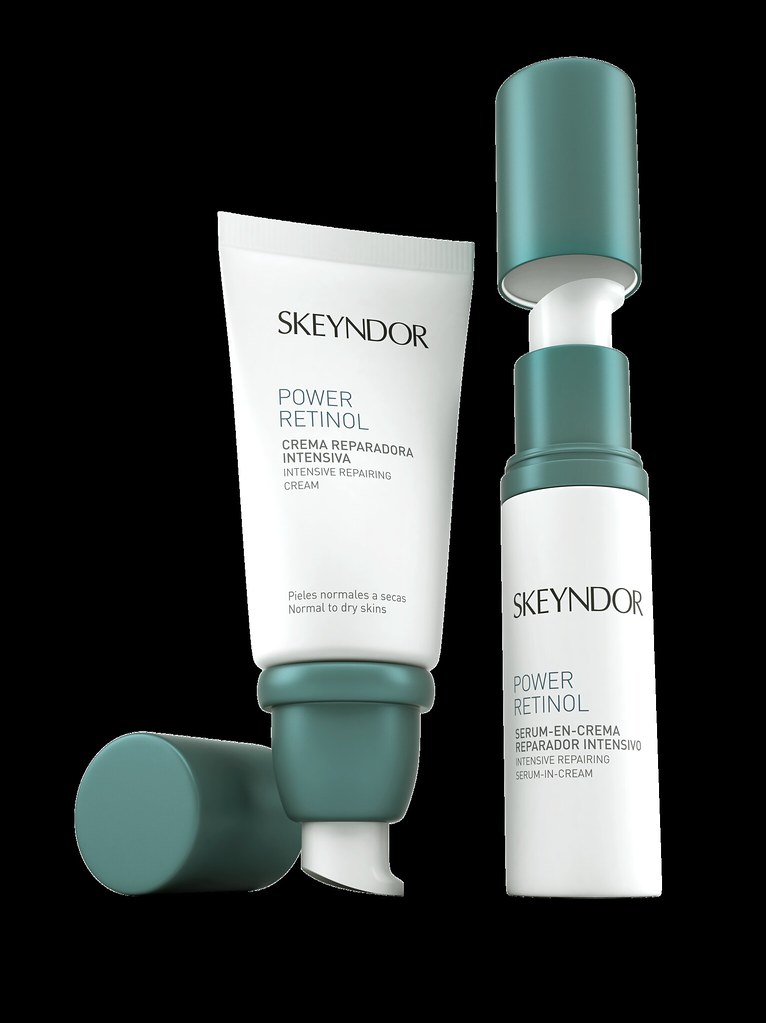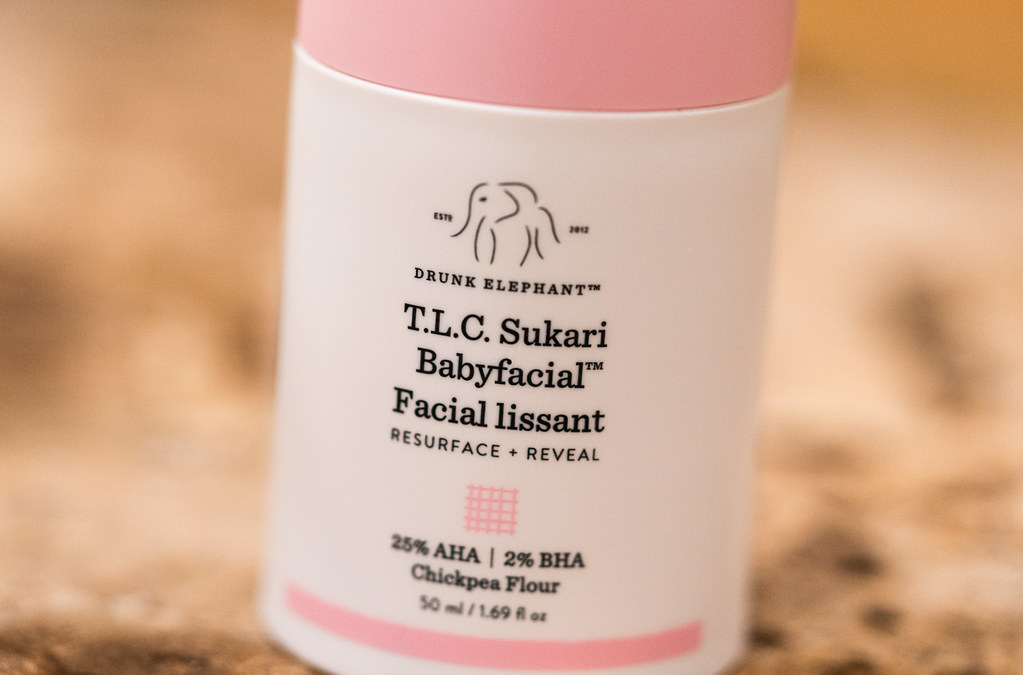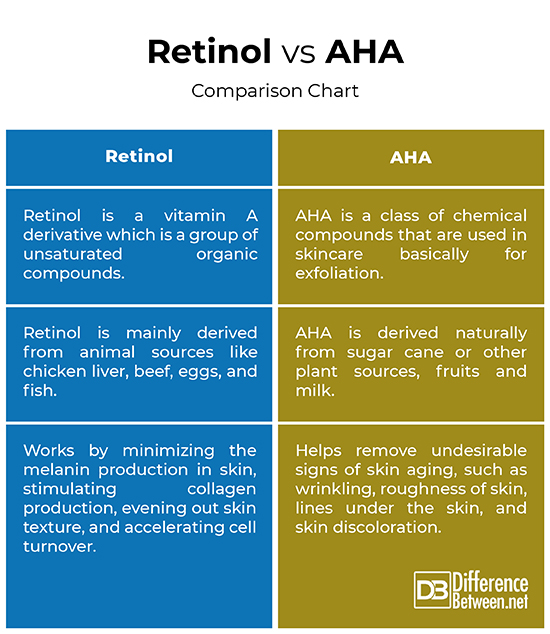Difference Between Retinol and AHA
The two most important ingredients that help to reduce anti-aging effects on your skin or help prevent future aging are retinol and alpha hydroxy acids (AHA’s). The actualization of eternal youth is a long-held dream. And who wouldn’t want to look ten years younger and reverse the effects of time, especially on your skin. Well, this isn’t impossible. With the right intervention, you can reverse years- worth of age-related damage in a few weeks time. One way to do it is to use a daily sunscreen because sun is probably one of the biggest causes of premature aging of the skin. Or you can use anti-wrinkle or anti-aging creams which contain potent exfoliators and wrinkle preventers like retinol and AHA’s.

What is Retinol?
Retinol is a catchall term for topical products, especially creams that contain a vitamin A derivative known as retinoids, which is found in several over-the-counter skincare lines. The topical use of retinoids has been studied extensively more than any other compound in dermatology. Retinol is used as an active ingredient in several over-the-counter skincare products and used for reducing anti-aging effects on your skin. It is another form of vitamin A which helps to minimize fine lines and reduce the appearance of pores. It is a powerful anti-aging ingredient which helps regulate the growth and differentiation of keratinocytes, which act as a defensive barrier against the microbial colonization.
Retinol helps to exfoliate the top layer of the skin to make the brown spots look lighter and less visible. It is also recommended by dermatologists for use every single day of the week regardless of your age or the skin type. So, it can help with age-related skin discolorations if any without any noticeable side effects. It works just like vitamin C; it sheds the old cells and stimulates the formation of new cells. But there’s one thing which only retinol can do; that is, it can reprogram the old cells to make them look like youthful skin cells. It helps stimulate collagen production and even out skin tone.

What is AHA’s?
Alpha Hydroxy Acids (AHA’s) are a class of chemical compounds that are used in skincare basically for exfoliation. AHA’s are water-soluble acids that are derived from sugar cane or other plant sources, therefore these acids are often called fruit acids. They are derived naturally or synthetically and they come in a variety of different forms, including glycolic, tartaric, lactic, malic, citric, and mandelic acid. The most commonly used AHA’s are lactic acid which is derived from milk and glycolic acid which is derived from sugar cane. Both are excellent exfoliators that can penetrate the surface of the skin, burn off old cells, and stimulate the growth of new cells.
AHA’s are believed to have derived from the chemical peels that plastic surgeons and dermatologists have been using for several years. The peels are excellent cosmetic stuffs that help remove undesirable signs of skin aging, such as wrinkling, roughness of skin, lines under the skin, and skin discoloration. The AHA’s products that are typically sold to consumers have an AHA concentration of 10 percent or less, while the professional cosmetologists can have the AHA concentration anywhere between 20 and 30 percent, and for doctors use, it can be 50 to 70 percent.
Difference between Retinol and AHA
Derivative
– Retinol belongs to the family of vitamin A derivatives which are a group of unsaturated organic compounds and vital nutrient for healthy vision, the immune system, reproduction, and especially skincare. It is another form of vitamin A which helps to minimize fine lines and reduce the appearance of pores. AHAs, on the other hand, are a class of chemical compounds that are used in skincare basically for exfoliation. They are water-soluble acids that are derived either naturally from sugar cane or other plant sources, or synthetically.
Form
– There are plenty of several different forms of retinol in widespread use. Retinol ranges from over the counter options such as retinaldehyde (RAL), retinol esters, and retinol, to prescription medication Tretinoin, Adapelene, Tazarotene, and Trifarotene. AHAs, on the other hand, primarily come in six different forms: glycolic, tartaric, lactic, malic, citric, and mandelic acid. The most commonly used forms of AHAs are lactic acid which is derived from milk and glycolic acid which is derived from sugar cane, and both are excellent exfoliators.
Use
– Retinol works by minimizing the melanin production in skin and also helps in stimulating collagen production, evening out skin texture, and accelerating cell turnover. It is a powerful anti-aging ingredient which helps regulate the growth and differentiation of keratinocytes, which act as a defensive barrier against the microbial colonization. AHA is yet another excellent exfoliator that helps remove undesirable signs of skin aging, such as wrinkling, roughness of skin, lines under the skin, and skin discoloration.
Retinol vs. AHA: Comparison Chart

Summary
While both retinol and alpha hydroxyl acids are excellent exfoliators and wrinkle preventers that help reduce the signs of skin aging by decreasing fine lines and wrinkling effects, they work a little differently. Retinol is probably the most commonly used non-prescription form of vitamin A which proves to be a great exfoliator that has the ability to penetrate the skin more effectively and it is also highly sensitive to light and air during skincare formulation. AHAs, on the other hand, are mostly sold to consumers in face and body creams and lotions, and there are several benefits associated with the use of AHAs in the skin care regimen.
- Difference Between Caucus and Primary - June 18, 2024
- Difference Between PPO and POS - May 30, 2024
- Difference Between RFID and NFC - May 28, 2024
Search DifferenceBetween.net :
Leave a Response
References :
[0]Shiomi, Naofumi. Molecular Mechanisms of the Aging Process and Rejuvenation. Rijeka, Croatia: Intech Open, 2016. Print
[1]Whitaker, Julian and Carol Colman. Shed 10 Years in 10 Weeks. New York, United States: Simon and Schuster, 1999. Print
[2]Burgess, Cheryl M. Cosmetic Dermatology. Berlin, Germany: Springer, 2005. Print
[3]Gilchrest, Barbara A. and Jean Krutmann. Skin Aging. Berlin, Germany: Springer, 2006. Print
[4]Image credit: https://live.staticflickr.com/65535/48650640353_f54e138769_b.jpg
[5]Image credit: https://live.staticflickr.com/3955/15028510784_46bac4de0a_b.jpg
